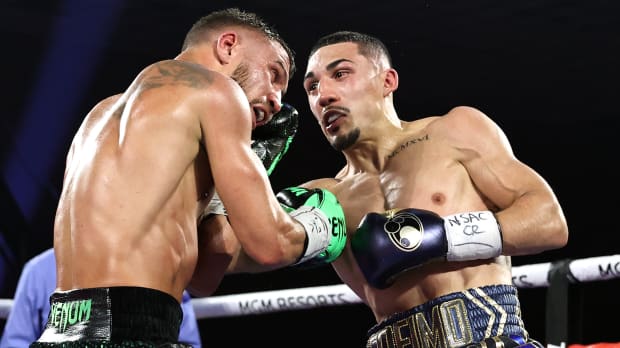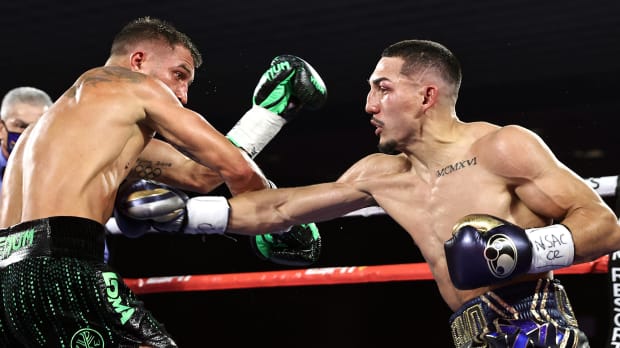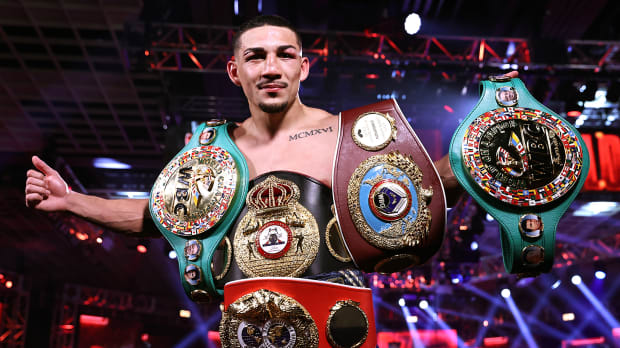Teofimo Lopez upset Vasiliy Lomachenko on Saturday to clean up a mess his father started two years ago.
LAS VEGAS – The Lopez family sat behind the ring, although none of them sat much. They yelled and screamed and hollered from the opening bell to the very last second of the quarantined bout here Saturday, providing a striking contrast to the strange night of top-level boxing inside the Top Rank bubble. Here, everything seemed quieter, the celebrations muted, the loudest sounds coming from the announcers. At least, that is, until the main event.
That’s when the family of Teofimo Lopez ended the library ambiance with a cacophony of funny and X-rated barbs. And that’s when Lopez himself burst the respective bubbles of oddsmakers, pound-for-pound list makers and the many who believed Vasiliy Lomachenko to be the best fighter in the world. Before the action started, most expected that if Lopez could win, he would win by knockout. By one big punch. But that’s not what happened. Lopez controlled the fight, winning it with brains as much as brawn, elevating his so-called Takeover to another level.
“I thought he fought a brilliant fight,” Bob Arum, chairman of Top Rank, said afterward. “Everybody felt he would win by KO. But instead, he boxed the s--- out of him for the first six rounds.”
Asked for a comparable boxer, in style, skill, attitude and, well, chutzpah, at only 23 years old, Arum shrugged. Not really, his shoulders seemed to say. Followed by, “He’s unique.”

The final scores (116-112, 119-109, 117-111) left some room for interpretation. But Lopez–and Arum–did not. Arum said the judge with the lopsided score should be fired. Lopez (16-0, 12 KOs), for once, didn’t need to say much. His performance said it all, announcing him as a legitimate contender not just at lightweight but as one of the top boxers in the sport. “The guy was just too big for [Lomachenko],” Arum said.
Make no mistake: this particular bout, in any other time, staged outside of this particular bubble, could have sold out Madison Square Garden. It could have been delayed and peddled on pay-per-view and held before a raucous crowd. That it wasn’t, that it basically took place behind closed doors but on national TV, was actually … more interesting.
The other bouts in the ballroom sounded quiet, even with the music and the piped-in crowd noise. It sounded like a boxing match wanted to be discreet, so discreet that anyone inside could hear the announcers, well, announcing—and the corners shouting instructions and even the fighters’ individual grunts. It looked like a regular fight in some ways, all the strobe lights and flashing signs and these huge video screens that stretched 28 feet wide and stood 18 feet tall. The only difference, which was a big difference, was the spacing—and in a sport known for crowding, no less. Writers found something they’d never had before at a big fight: elbow room. No one sat close to anyone else, not even the commentators. Every time someone sneezed, half the room jumped out of their seats.
When the first televised fight ended in one minute and 19 seconds, with Edgar Berlanga registering his 15-straight first-round knockout to begin an intriguing career, boxing in 2020 sharpened into focus. Berlanga climbed the ropes and bellowed, "I’m a f----- monster." Without a rowdy crowd celebrating an emphatic barrage, he sounded scarier. One person sitting nearby jumped a little in his seat. It was like someone had just cranked the remote to max volume in a nursing home.
Top Rank employees shuffled back and forth, between the TV set and the ring. Sometimes, it was more fun watching them react to the fight than studying the in-ring action. Like being transported into their living rooms.
After the lights dropped for the main event and fire began raging on those big screens and a heartbeat thudded over and over, Lopez took control of fight. He did so early, immediately, with what looked like relative ease. Being bigger helped but let’s not diminish how well he moved, how deftly he stalked, how, whenever Lomachenko circled, Lopez trailed close behind.
Early the pace was slow, deliberate, which would have seemed to favor Lomachenko. But not Saturday, when Lopez took the fight to—and from—him. If the Ukrainian champ had a best round in the first half it was 2, and even then, many scored the stanza for Lopez. He pushed the action. He imposed his larger body. He made it so Lomachenko could not go right, a favored tactic for Loma, but one that leaves a southpaw vulnerable to a strong right hand. His family yelled so loud that in the silent bubble a TV audience could hear them. “You’re a Lopez!” someone in the family section shouted.
At one point, ESPN commentators suggested Lomachenko needed to begin to throw. It was easier to say that when Lopez stood 20 feet away, rather than three. But the analyst was right.
This wasn’t how most expected the first half of the fight to unfold. It was impossible for any person who simply enjoys a good scrap every once in a while to dislike the elements in play for a bout of this magnitude. This fight had all the makings of a classic, which doesn’t always translate (see: Saturday), but when the backdrop and the combatants and their history and the fight itself all coalesce on the same evening, we’re reminded of why boxing was once America’s most-popular and most-anticipated sport. Why the country used to stop for it.

Here were two boxers, both champions, with four belts between them. There was contrast in age: Lopez, the youngest champion in boxing, at only 23; Lomachenko an in-prime 32. There was contrast in resumés: Lomachenko, the sport’s amateur king, with two gold medals and almost 400 victories before he turned pro; Lopez, with far less amateur experience, but an electric start to his budding career. There was a contrast in demeanor and approach: Lomachenko, stoic by nature, a clinician by training, a fighter who speaks with his fists; Lopez, Brooklyn boisterous, bred to be loud and back up his claims. On top of all of that, the fight would be shown on ESPN, opening a window to a wider, mainstream audience.
Those tuning in would see, clearly and immediately, what Sports Illustrated first detailed in September. That these two boxers don’t like each other, not even a little, and the genesis of their feud began in a Manhattan hotel lobby two years ago, near an elevator bank. Both had participated in a news conference earlier that day, two days before Lomachenko would headline a card in The Theater at Madison Square Garden. Lopez, by then rising up the lightweight division like an elevator stuck on upward, would fight on the undercard.
Both men are trained by their fathers, and so the elder Teofimo Lopez—he’s not sure how many generations back the name goes—approached Lomachenko by that elevator bank. The elder Lopez says Lomachenko snubbed him, refusing to acknowledge his presence or even return a quick hello. So while Lopez the boxer went upstairs to his suite, his father made a u-turn out of an elevator and beelined for the Ukrainian champion. No one disputes what happened next, not even the elder Lopez. He saddled right up close to Lomachenko and began to scream at him. He said that his son would steal the upcoming show like he had stolen attention on other Lomachenko cards before. He made fun of Lomachenko’s height and size, using offensive terms. He made death threats.
Eventually, the men were separated. Lomachenko stared forward, silent, unblinking and clearly upset. Lawyers got involved. It was decided that Lopez would never again fight on a Lomachenko card–unless, that is, they fought each other, which seemed, at best, a long ways away. Lomachenko told bystanders, “Nobody talks to me like that. I’m not an animal.” And, when the father Lopez finally went upstairs and told his son what happened, the boxing Lopez responded that he would “clean up” the whole mess. “Don’t worry, dad,” the fighter said. “I always go out and prove you right.”
The bad blood only built until Friday’s weigh-in, where an already strange prospect—watching extremely fit humans step on scales in their underwear—took on an even-more-unusual tone. Sure, there were swirling spotlights and logos splashed everywhere and massive HD screens promoting the combatants and their beef. But there weren’t fans. There weren’t stands. This wasn’t in Grand Garden Arena, the MGM’s longtime home for the biggest fights. This was in a convention center, and while the undercard boxers climbed atop a stage that would later transform into the ring they fought in, they actually stood six feet apart for their stare-downs.
When the song "Hey, DJ" started pumping through the speakers in the ballroom, the line "Where’s my DJ?" took on significant meaning. There were no turntables in site. Perhaps there was someone spinning somewhere, at a safe distance and, of course, wearing a mask.
This marked the 22 show that Top Rank would put on inside its MGM bubble, and for Brad Jacobs, the company’s logistical magician and COO, the ever-shifting, ever-contagious landscape of 2020 proved more difficult than fights he put on in empty rodeo barns or Mexican bull rings. “This certainly, in all respects, tops everything,” he says.
For a “normal” show, Jacobs would check some 250 items of his to-do list. For the bubble shows? More like 400. Top Rank had been one of the first major entities in sports to return as the pandemic rage, and they hosted their first event, in June, only three days after MGM re-opened, only a week after the Nevada Athletic Commission had granted approval and just days after ESPN, Top Rank’s partner, allowed crews to return to the road.
The bubble seemed to work. It caught positive tests and led to quarantining of anyone who could spread COVID-19. Boxers were only allowed two team members and everyone, including media for Lomachenko-Lopez, stayed on the 12floor of the MGM’s Grand Tower, where they were tested regularly in the evenings, the results worked up by a lab at a nearby hospital overnight. Jacobs had worried that fighters would beg to include their “assistant meditation coach” but no one complained. Some team members who tested positive even rented cars and drove back as far as to New York. All of which culminated in the fight at hand.
Back at the weigh-in, word started to spread that Lopez would not make weight. Some said he was even 2.5 pounds over the 135-pound limit. By chance, I had seen him late Thursday on the 12 floor of the MGM, where everyone stayed to follow bubble protocol. He had been running, wearing all sorts of clothes, up and down the hallway. It seemed odd. But he stepped confidently on the scale, sporting a black T-shirt he wore to honor his friend, Disney Ramirez, who had died in a motorcycle accident earlier this year. Lopez came in at exactly 135, same as Lomachenko. But only Lopez screamed out yes! and pumped a fist when he made weight.
At that point, the social distancing went out the window. Lopez slipped under the rope nearest him and shot toward Lomachenko, who waited not even a millisecond, slipping under his own rope and moving forward like a cobra that felt threatened. The face-off was brief but said it all. “In my country, we have different rules,” Lomachenko had noted in the lead-up. “If you say you’re going to do something, you have to back it up.”

As the fight drew near, boxing did what boxing does, trying to convince the world – and itself—that both fighters had an equal chance to win. Lopez was, after all, younger and bigger and held a three-inch reach advantage, which is significant at any weight but particularly at the lower ones. Afraid? This was a power puncher who did backflips after knockouts. Lomachenko, meanwhile, had moved up from featherweight to lightweight, and against opponents who were bigger than him, he was still elite – four wins, two stoppages—but not nearly as intimidating. He took punishment in those fights, too, even suffered his first pro knockdown. Had he gone up too high in weight, too fast? Lopez not only believed that; he told anyone who would listen. “Put all your money on my son, man,” his father shouts back in September. “You’re gonna get rich!”
Conversely, many wondered if Lopez took this level of fight too early, before he had truly formed the best version of his boxing self. Perhaps Lomachenko would hand the young titlist his first loss, like Orlando Salido had done to Loma, by catching him off guard, smothering him and teaching a boxer with less pro-experience a valuable fistic lesson: be careful what you wish for. Lomachenko took that loss, the way that Salido bullied him and made him uncomfortable, and adjusted, en route to staking his claim as the best boxer in the world.
Timothy Bradley, the world champion turned sharp ESPN analyst, wondered how the unprecedented circumstances would impact the boxers themselves in the same way but related to the pandemic. He recalls in great detail arriving for big fights like this one, when the MGM is uncomfortably packed and there’s a ring set up near the lobby entrance with a huge Lion in the center. For a boxer who feeds off of attention, who wants to draw energy from a crowd, Bradley wondered how would it feel in front of only 250 fans, all sponsors or first responders let in by Top Rank. Would the muted portions of the evening impact Lopez in particular?
And yet, Bradley knows, from his own experience, how winning a title can boost a fighter’s mojo. He says that winning your first one can make you 30 percent better, and Lopez did just that last December, dispatching Richard Commey in three rounds. When Bradley did the same, in 2008, he flew to England, entered a hostile arena, and out-pointed Junior Witter by split decision. Victory confirmed for Bradley what he thought he already knew deep down. That he had the skills to beat the best boxers in the world, and that he wanted—no, desired—to go after them. He could relate to Lopez’s desires. “It changes everything; it really does,” he says. “That’s part of why this is a historic night, for both fights, and for boxing, and not just because of the bubble. I’m going to be talking about this night when I’m 70, 80 years old.”
Bradley wasn’t wrong. A lopsided fought got closer in the second half, as Lomachenko, forced to throw or fold, tried his best to hit the larger man. He closed the gap. Made it closer. He hit Lopez with some combinations. But his face had been touched up. He was bleeding from above the right eye. Lopez ended up bleeding, too, but due to a headbutt, and as the final bell sounded, his torso was flecked with his own blood. That seemed fitting, given the way he fought.
The Lopez family never stopped screaming. Lopez the fighter never stopped coming. The buzz at ringside was that the bout might end in a draw, that it had been closer than many believed, that it looked closer on TV. Instead, Lopez, by a landslide, and his father thumped his chest and his sister shouted about disrespect and for a minute, it didn’t feel like a bubble anymore. It felt like the announcement of boxing’s next big thing.

0 Comments:
Post a Comment